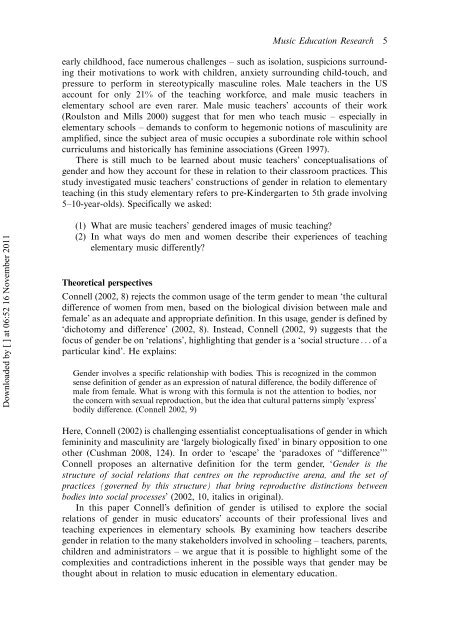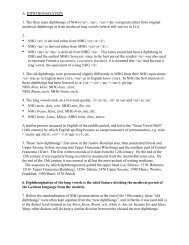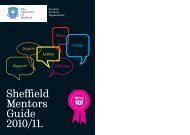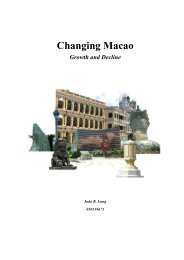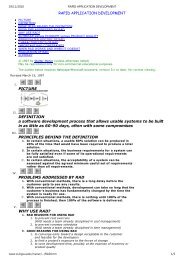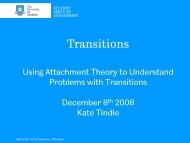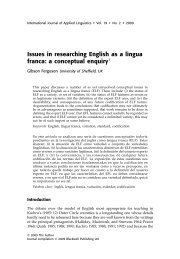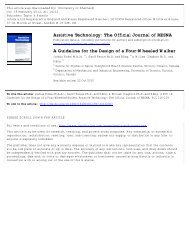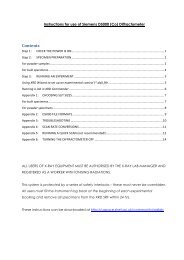Music teachers' constructions of gender in elementary education
Music teachers' constructions of gender in elementary education
Music teachers' constructions of gender in elementary education
You also want an ePaper? Increase the reach of your titles
YUMPU automatically turns print PDFs into web optimized ePapers that Google loves.
Downloaded by [ ] at 06:52 16 November 2011<br />
<strong>Music</strong> Education Research 5<br />
early childhood, face numerous challenges such as isolation, suspicions surround<strong>in</strong>g<br />
their motivations to work with children, anxiety surround<strong>in</strong>g child-touch, and<br />
pressure to perform <strong>in</strong> stereotypically mascul<strong>in</strong>e roles. Male teachers <strong>in</strong> the US<br />
account for only 21% <strong>of</strong> the teach<strong>in</strong>g workforce, and male music teachers <strong>in</strong><br />
<strong>elementary</strong> school are even rarer. Male music teachers’ accounts <strong>of</strong> their work<br />
(Roulston and Mills 2000) suggest that for men who teach music especially <strong>in</strong><br />
<strong>elementary</strong> schools demands to conform to hegemonic notions <strong>of</strong> mascul<strong>in</strong>ity are<br />
amplified, s<strong>in</strong>ce the subject area <strong>of</strong> music occupies a subord<strong>in</strong>ate role with<strong>in</strong> school<br />
curriculums and historically has fem<strong>in</strong><strong>in</strong>e associations (Green 1997).<br />
There is still much to be learned about music teachers’ conceptualisations <strong>of</strong><br />
<strong>gender</strong> and how they account for these <strong>in</strong> relation to their classroom practices. This<br />
study <strong>in</strong>vestigated music teachers’ <strong>constructions</strong> <strong>of</strong> <strong>gender</strong> <strong>in</strong> relation to <strong>elementary</strong><br />
teach<strong>in</strong>g (<strong>in</strong> this study <strong>elementary</strong> refers to pre-K<strong>in</strong>dergarten to 5th grade <strong>in</strong>volv<strong>in</strong>g<br />
5 10-year-olds). Specifically we asked:<br />
(1) What are music teachers’ <strong>gender</strong>ed images <strong>of</strong> music teach<strong>in</strong>g?<br />
(2) In what ways do men and women describe their experiences <strong>of</strong> teach<strong>in</strong>g<br />
<strong>elementary</strong> music differently?<br />
Theoretical perspectives<br />
Connell (2002, 8) rejects the common usage <strong>of</strong> the term <strong>gender</strong> to mean ‘the cultural<br />
difference <strong>of</strong> women from men, based on the biological division between male and<br />
female’ as an adequate and appropriate def<strong>in</strong>ition. In this usage, <strong>gender</strong> is def<strong>in</strong>ed by<br />
‘dichotomy and difference’ (2002, 8). Instead, Connell (2002, 9) suggests that the<br />
focus <strong>of</strong> <strong>gender</strong> be on ‘relations’, highlight<strong>in</strong>g that <strong>gender</strong> is a ‘social structure ...<strong>of</strong> a<br />
particular k<strong>in</strong>d’. He expla<strong>in</strong>s:<br />
Gender <strong>in</strong>volves a specific relationship with bodies. This is recognized <strong>in</strong> the common<br />
sense def<strong>in</strong>ition <strong>of</strong> <strong>gender</strong> as an expression <strong>of</strong> natural difference, the bodily difference <strong>of</strong><br />
male from female. What is wrong with this formula is not the attention to bodies, nor<br />
the concern with sexual reproduction, but the idea that cultural patterns simply ‘express’<br />
bodily difference. (Connell 2002, 9)<br />
Here, Connell (2002) is challeng<strong>in</strong>g essentialist conceptualisations <strong>of</strong> <strong>gender</strong> <strong>in</strong> which<br />
fem<strong>in</strong><strong>in</strong>ity and mascul<strong>in</strong>ity are ‘largely biologically fixed’ <strong>in</strong> b<strong>in</strong>ary opposition to one<br />
other (Cushman 2008, 124). In order to ‘escape’ the ‘paradoxes <strong>of</strong> ‘‘difference’’’<br />
Connell proposes an alternative def<strong>in</strong>ition for the term <strong>gender</strong>, ‘Gender is the<br />
structure <strong>of</strong> social relations that centres on the reproductive arena, and the set <strong>of</strong><br />
practices (governed by this structure) that br<strong>in</strong>g reproductive dist<strong>in</strong>ctions between<br />
bodies <strong>in</strong>to social processes’ (2002, 10, italics <strong>in</strong> orig<strong>in</strong>al).<br />
In this paper Connell’s def<strong>in</strong>ition <strong>of</strong> <strong>gender</strong> is utilised to explore the social<br />
relations <strong>of</strong> <strong>gender</strong> <strong>in</strong> music educators’ accounts <strong>of</strong> their pr<strong>of</strong>essional lives and<br />
teach<strong>in</strong>g experiences <strong>in</strong> <strong>elementary</strong> schools. By exam<strong>in</strong><strong>in</strong>g how teachers describe<br />
<strong>gender</strong> <strong>in</strong> relation to the many stakeholders <strong>in</strong>volved <strong>in</strong> school<strong>in</strong>g teachers, parents,<br />
children and adm<strong>in</strong>istrators we argue that it is possible to highlight some <strong>of</strong> the<br />
complexities and contradictions <strong>in</strong>herent <strong>in</strong> the possible ways that <strong>gender</strong> may be<br />
thought about <strong>in</strong> relation to music <strong>education</strong> <strong>in</strong> <strong>elementary</strong> <strong>education</strong>.


